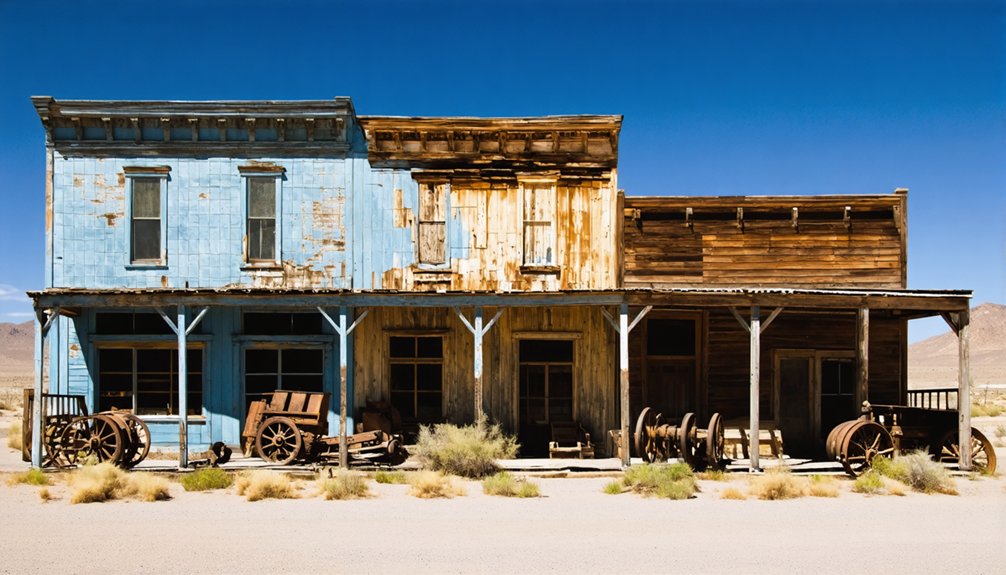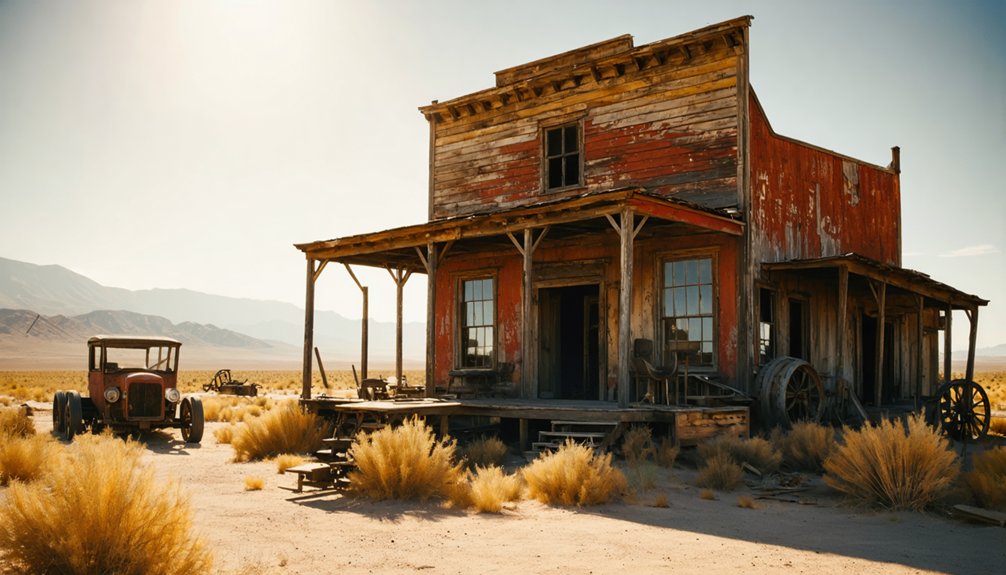Gamba is a remote California ghost town that emerged during the late 19th century desert mining boom. You’ll find remains of the general store with its wooden siding and false-front façade, plus a roofless post office with its stone foundation intact. High-clearance 4×4 vehicles are essential for accessing this site, and visiting during golden hour provides the best photography opportunities. Unlike the more famous Bodie, Gamba offers a less documented but authentic glimpse into frontier mining history.
Key Takeaways
- Gamba emerged as a mining town in late 19th century Southern California before declining due to depleted resources and regulatory changes.
- The site contains architectural remains including a general store with original wooden siding and a roofless post office with stone foundation.
- Harsh conditions and minimal infrastructure made daily life challenging, with miners working from dawn to dusk in hazardous environments.
- Accessing Gamba requires high-clearance 4×4 vehicles, with visitors advised to bring ample water and navigate only during daylight hours.
- Unlike well-preserved ghost towns like Bodie, Gamba has fewer documented structures but offers insights into frontier mining engineering and history.
The Rise and Fall of Gamba’s Mining Industry
While California’s gold rush history typically evokes images of the 1849 Sierra Nevada stampede, the mining town of Gamba emerged later in the 19th century as part of Southern California’s desert mining developments.
By 1877, improved transportation allowed efficient bullion shipment from this remote region. The American River’s gold discovery in 1848 had already established California as a premier mining destination decades earlier.
You’d have witnessed a typical progression in mining techniques, from early placer operations to sophisticated hard-rock extraction. Like many areas in Calaveras County, Gamba saw quartz vein discoveries that revitalized mining activity after initial placer mining declined. Rich ore averaging $12 per ton attracted both small-scale prospectors and larger commercial operations. The town flourished as auxiliary industries developed around the mines.
As the new century dawned, cyanide processing allowed miners to extract gold from lower-grade ores, temporarily extending the industry’s life.
Eventually, economic fluctuations, depleted high-grade deposits, and rising operational costs led to Gamba’s decline, mirroring the fate of many boom-and-bust mining communities across the American West.
Daily Life in a California Boom Town
Three distinct aspects shaped daily life in 1880s Gamba: work, leisure, and survival.
You’d rise before dawn if you were a miner, facing hazardous conditions and backbreaking labor until dusk—the harsh reality of mining culture. Meanwhile, merchants and saloon keepers served the community from sunrise to well past midnight.
Your evenings might include visits to saloons or gambling halls where racial tensions often simmered beneath forced civility. The city’s growth mirrored that of Los Angeles where the population surged from about 11,000 to over 50,000 during the 1880s. You’d contend with daily struggles like contaminated water, disease outbreaks, and minimal medical care. The lack of proper sanitation claimed many lives.
Community gatherings at dances or Odd Fellows meetings offered brief respite from the hardships. Local newspapers and periodicals documented both the ordinary and extraordinary events that unfolded in this tumultuous town.
Women ran essential businesses like laundries and boarding houses, becoming the backbone of Gamba’s precarious economy despite their lower social standing.
Architectural Remains and Notable Structures
Despite enduring decades of abandonment, Gamba’s architectural remains provide a tangible window into the town’s brief but vibrant history.
You’ll find Gamba’s general store still standing with its original wooden siding and false-front façade—an example of architectural significance common in late 19th-century mining settlements.
Throughout town, structures showcase locally sourced timber and stone construction. The post office, though roofless, maintains its stone foundation, while the blacksmith shop‘s remnants include scattered metal tools.
The community’s religious center is marked by partial church walls, and mining operations are evident through rusted equipment and mill foundations. Similar to Bombay Beach in the 1970s, the area experienced ecological disasters that contributed to its eventual abandonment.
For those interested in historical preservation, Gamba’s infrastructure offers insights into frontier engineering: stone-lined drainage ditches, visible wagon ruts, and evidence of early electrical systems that once powered this now-silent California boomtown. Similar to Bodie, these structures are being maintained in a state of arrested decay, allowing visitors to experience authentic remnants of the past.
Why Gamba Was Abandoned: Economic and Environmental Factors
The architectural remains that still dot Gamba’s landscape tell only half the story—behind these silent structures lies a complex tale of economic failure and environmental challenges.
Gamba’s decline began when its once-rich gold and silver veins depleted, triggering severe economic decline as mining operations became unprofitable. You’ll find evidence of hydraulic mining‘s environmental degradation throughout the area, a practice eventually banned for its destructive impact. This regulatory change further crippled the town’s fragile economy. These abandoned buildings now serve as silent testaments to the boom and bust cycles that characterized many California mining settlements. Like Bodie, Gamba experienced devastating fires that destroyed a significant portion of its original structures, with only a small percentage of historic buildings remaining today.
The town’s remote mountainous location exacerbated these problems, with harsh winters and limited accessibility making everyday life increasingly difficult.
When the railway service ended, Gamba lost its essential connection to larger markets. As mining jobs disappeared, residents migrated to California’s growing agricultural regions and cities offering more stable opportunities.
Visiting Gamba Today: Access and Photography Tips

You’ll need a high-clearance 4×4 vehicle to navigate the rough, unpaved roads leading to Gamba’s remote desert location.
For the best photography results, plan your visit during early morning or late afternoon when the golden hour light creates dramatic shadows across weathered structures. The scenic desert backdrop provides a perfect setting for capturing authentic Old West history through your lens. During your visit, you may meet friendly staff who can share fascinating details about the local mining and railroad history.
Remember to pack plenty of water, offline maps, protective gear for your camera equipment, and emergency supplies as cell service is nonexistent in this isolated area.
Challenging Road Conditions
Venturing to Gamba presents some of the most challenging road conditions found among California’s ghost towns, as no maintained routes exist to this obscure destination.
You’ll need to rely entirely on topographic maps and GPS for navigation, as official directions and signage are nonexistent. Road safety depends on your preparation—high-clearance 4×4 vehicles are essential for traversing the likely washouts, deep ruts, and sand traps.
- Always check weather forecasts before departure, as seasonal conditions can render routes impassable with flash floods or extreme temperatures
- Pack vehicle maintenance supplies including recovery gear, spare tires, and tools for self-extraction
- Travel only during daylight hours to avoid hidden hazards like unmarked mine shafts and uneven terrain
Optimal Lighting Hours
For ideal photography at Gamba, timing your visit around golden hour conditions proves essential, as the first and last hours of daylight transform this weathered ghost town into a photographer’s paradise.
The soft, warm light enhances textures on decaying structures while minimizing harsh shadows that plague midday shoots.
Early morning visits offer cooler temperatures and clearer air, perfect for capturing the ruins bathed in gentle easterly light.
Alternatively, late afternoon provides dramatic long shadows that accentuate architectural details. Both times represent prime conditions for quality photographs.
Avoid midday sun, which creates excessive contrast and washed-out images.
On cloudy days, you’ll benefit from naturally diffused lighting that evenly illuminates Gamba’s historical remains.
Always bring a tripod for low-light shooting during these golden hours.
Remote Location Preparation
Preparing thoroughly before attempting to reach Gamba’s isolated remains is absolutely essential, as the ghost town’s remote Mojave Desert location presents significant logistical challenges for visitors.
You’ll need to outfit your vehicle with spare tires and recovery equipment, as the unpaved desert roads require high-clearance vehicles and can become impassable after weather events.
For this remote location, preparation essentials include:
- At least one gallon of water per person per day, plus extra emergency supplies
- Paper maps and written directions, as GPS is unreliable in this area
- Sufficient fuel for the round trip, with no services available nearby
Pack all necessary food, camping gear if staying overnight, and inform someone of your itinerary with expected return time.
Remember that cell reception is nonexistent, making self-reliance vital.
Comparing Gamba to Other California Ghost Towns

When comparing Gamba to California’s more renowned ghost towns like Bodie, stark contrasts emerge in scale, historical documentation, and preservation status.
While Bodie’s population swelled to 10,000 residents by 1880 and earned notoriety as California’s third-largest city, Gamba history reveals a smaller, less documented settlement. Bodie’s $34 million gold production dwarfed many smaller operations like Gamba’s.
You’ll find Bodie preserved as a State Historic Park attracting 200,000 annual visitors, with 170 structures maintained in “arrested decay.”
In contrast, Gamba population records remain sparse, and the site lacks significant preservation efforts. While Bodie’s infamous reputation earned it the saying “Goodbye God, we’re going to Bodie,” Gamba’s social environment never achieved such notorious status.
Both shared mining-driven booms and eventual abandonment, though at dramatically different scales.
Frequently Asked Questions
Are There Any Documented Paranormal Activities in Gamba?
There aren’t any documented ghost sightings or supernatural legends specific to Gamba. You won’t find official paranormal records for this ghost town, unlike Bodie or Calico which have extensive supernatural histories.
Who Were the Most Famous or Notorious Residents of Gamba?
Like ghosts in the mist of time, Gamba’s Famous Residents and Notorious Figures haven’t survived in historical records. You’d find only nameless miners, entrepreneurs, lawmen, and civic leaders who once called Gamba home.
What Native American Tribes Originally Inhabited the Gamba Area?
You’d find the Tongva (also called Gabrieleño) Nation originally inhabited the Gamba area. They maintained rich Tribal Traditions across the Los Angeles Basin before Spanish missions disrupted their Chumash Heritage and ancestral lands.
Were Any Movies or Television Shows Filmed in Gamba?
In a world starved for authentic ghost town footage, you won’t find Gamba films or Gamba shows documented anywhere. Unlike Bodie and Calico, no records exist of productions filmed there.
What Happened to Gamba During Prohibition and the Great Depression?
You’d find Prohibition impact on Gamba mirrored other mining towns—saloons closed, social fabric unraveled. Great Depression effects finished the job, crushing mining operations and triggering mass exodus as residents fled economic collapse.
References
- https://www.youtube.com/watch?v=OD9M6MP6RRU
- https://www.camp-california.com/california-ghost-towns/
- https://www.californist.com/articles/interesting-california-ghost-towns
- https://whimsysoul.com/must-see-california-ghost-towns-explore-forgotten-histories/
- https://www.atlasobscura.com/itineraries/the-wildest-west
- https://en.wikipedia.org/wiki/List_of_ghost_towns_in_California
- https://www.youtube.com/shorts/xpNGm1VT0iE
- https://www.publiclandsforthepeople.org/wp-content/uploads/2015/06/Desert-Fever-History-of-Mining-in-the-CDCA.pdf
- https://www.calaverashistory.org/mining
- https://www.goldrushwax.com/post/the-glittering-legacy-of-the-american-river-in-the-california-gold-rush



